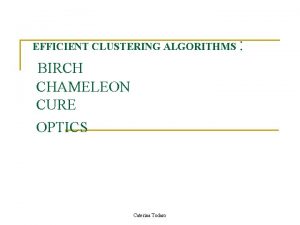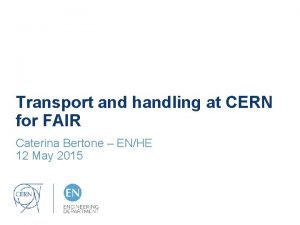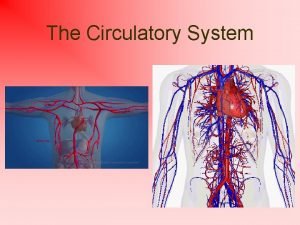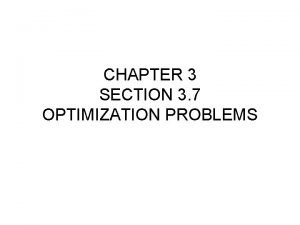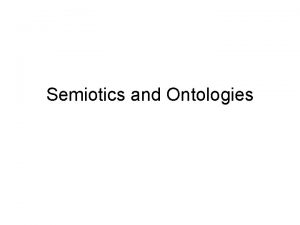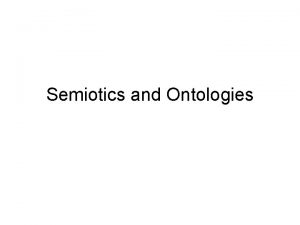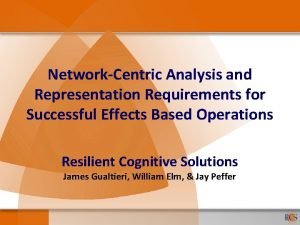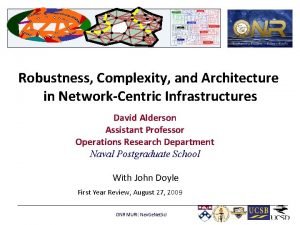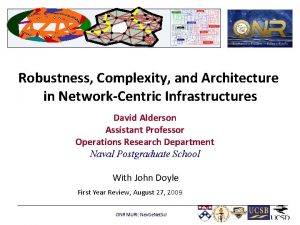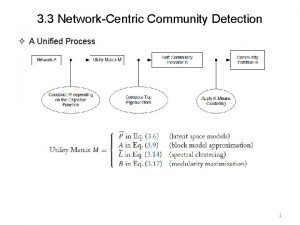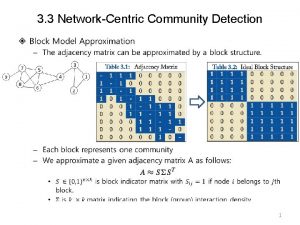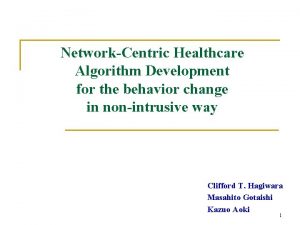NetworkCentric Partner Notication Strategies to Contain Epidemics Caterina








![Simulations • Gillespie-based algorithm [GEMF or others] • Each simulation has been repeated 350 Simulations • Gillespie-based algorithm [GEMF or others] • Each simulation has been repeated 350](https://slidetodoc.com/presentation_image_h2/2ad98b2031cac66a3d806ed926808390/image-9.jpg)












- Slides: 21

Network-Centric Partner Notification Strategies to Contain Epidemics Caterina Scoglio Electrical and Computer Engineering Kansas State University THE 2 ND ANNUAL MEETING OF SIAM CENTRAL STATES SECTION SEPTEMBER 30 – OCTOBER 2, 2016 UNIVERSITY OF ARKANSAS AT LITTLE ROCK

The problem: syphilis • The number of reported early syphilis cases in USA has increased steadily during the past several years. • It is not yet clear what factors are responsible for such an increase. • The members of the men-who-have-sex-withmen (MSM) community have a significantly higher chance of syphilis and HIV compared to non-member individuals. 2

Mitigation strategy • Partner notification definition: an infected individual notifies all his partners (neighbors in the sexual network) of his infectious state • Partner notification goals – 1) treating exposed partners, – 2) preventing reinfection of the index cases – 3) preventing infection of healthy partners. • Public health professionals face many challenges in partner notification, especially in populations using social media as a primary communication venue, or when most of the partners are anonymous. 3

Goal of this study • To define and evaluate new mitigation interventions for the syphilis epidemic exploiting the MSM sexual network • New interventions must be simultaneously effective and require limited additional costs – Definition based on the network structure – Evaluation based on extensive simulation 4

The sexual network The complete network includes 457 disconnected components, where 280 components have only two nodes (61. 3%), 75 components have 3 nodes, 56 components have a number of nodes included in the range 5 to 9. Only eleven components include more than 9 nodes, and one largest component includes 953 nodes. Complete network Sexual network largest component Number of nodes 2428 953 Number of edges Density Average Node Degree Variance Clustering coefficient Connected components 2046 6. 94 E-4 1. 68 6. 43 0. 014 457 1011 0. 002 2. 12 13. 27 0. 017 1

Sexual network–connected component One node has degree 58, four nodes have a degree in the range 11 to 13, and eleven nodes have degree 10. On the other side, 808 nodes have degree one and two. Largest connected component of the sexual contact network (left) and its node degree distribution (right). Network weighted by the duration of partnership. 6

The notification network • Through the notification network, the infection status of nodes can be notified to neighbors. • In the standard partner notification strategy, sexual network = notification network. • What about different structures of the notification network? 7

The multilayer SAIS model Transition diagram for each node in the network among the three states: susceptible (S), alert (SA), and infected (I), when the transition to the alert state can be induced by infected neighbors in the notification network. [Sahneh et al. ] 8
![Simulations Gillespiebased algorithm GEMF or others Each simulation has been repeated 350 Simulations • Gillespie-based algorithm [GEMF or others] • Each simulation has been repeated 350](https://slidetodoc.com/presentation_image_h2/2ad98b2031cac66a3d806ed926808390/image-9.jpg)
Simulations • Gillespie-based algorithm [GEMF or others] • Each simulation has been repeated 350 times selecting different sets of initially infected nodes (5%) • With the selected parameter values, the simulations converge in the long term to a non-zero number of infected individual Parameter a (1/day) 0. 94 0. 47 0. 02 0. 30 9

Community notification strategies • Community notification has the goal of alerting all nodes in the network when the index case belongs to a small subset of core nodes in the network • Only a generic alert message will be sent to the community with the purpose of inviting everyone to adopt effective preventing measures and to look for testing and treatment if needed 10

Network centric node selections • Amount – (5, 14, 30) • Centrality measure – Degree centrality (DC), Weighted degree centrality (WDC), Eigenvector centrality (EC). • Define the notification network 11

Comparison TABLE V C=0 C=5 C=14 C=30 SPN Rand DC WDC EC Additional links 0 4754 4587 4622 4739 13312 12980 13013 13285 28491 28015 28056 28483 Number of infected individuals 148 123 100 91 87 105 81 72 64 94 64 63 53 12

Comparison for C=14 The mean number of infected individuals as a function of time (days) in the population for four selection strategies of 14 most central nodes that broadcast their health status: standard PN (red), Rand (green), DC (blue), WD (magenta), and EC (black). 13

Eigenvector centrality notification efficiency 30000 120 25000 100 20000 80 15000 60 10000 40 5000 20 0 EC 5 to 553 EC 5 to 653 EC 5 to all EC 14 to 553 EC 14 to 653 EC 14 to all EC 30 to 553 EC 30 to 653 EC 30 to all additional links infected individuals 14 0

Authors • David Juher and Joan Saldana, Departament d'Informàtica, Matemàtica Aplicada i Estadística, Universitat de Girona 17071 - Girona, Catalunya (Spain) • Robert Kohn, San Francisco Public Health Department, USA • Kyle Bernstein, CDC, USA • Caterina Scoglio, KSU, USA 15

Concluding remarks and future work • If the notification is performed with a mobile phone app, minimizing the number of links is not a critical goal, and strategies like “broadcast the alert message if any of the 30 nodes with highest eigenvector centrality is infected” seems to be promising. • Preliminary study: many additional aspects of the modeling and implementation still require further assessment and development. • Future work: test network centrality measures based on p-modulus. 16

Acknowledgments • This work was supported by the National Science Foundation Award CIF-1423411 and Award DMS 1515810. 17

SIS epidemic model •

Generalized epidemic modeling framework •

GEMFsim algorithm •

GEMFsim algorithm •
 Marcia
Marcia Caterina cas
Caterina cas Dott.ssa caterina miscia bucchianico
Dott.ssa caterina miscia bucchianico Caterina rinaldi
Caterina rinaldi Caterina todaro
Caterina todaro Caterina valcu
Caterina valcu Caterina da siena leonardo da vinci
Caterina da siena leonardo da vinci Cubierta mercado santa caterina
Cubierta mercado santa caterina Caterina perugini
Caterina perugini Caterina ranieri alba
Caterina ranieri alba Caterina bertone - wikipedia
Caterina bertone - wikipedia Caterina spinaris
Caterina spinaris Caterina biscari
Caterina biscari Caterina minniti
Caterina minniti Post test the early and mid nineteenth century romanticism
Post test the early and mid nineteenth century romanticism A carbohydrate is an organic compound because it contain
A carbohydrate is an organic compound because it contain Independent vs dependent sentences
Independent vs dependent sentences A bit can have only two possible values
A bit can have only two possible values Blood contain
Blood contain Brass metallic bond
Brass metallic bond 7-2 eukaryotic cell structure
7-2 eukaryotic cell structure A rectangular page is to contain 24 sq in of print
A rectangular page is to contain 24 sq in of print




